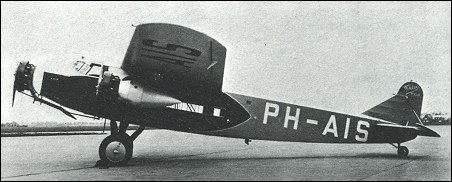 |
Fokker F.181932 |  |
| PASSENGER | Virtual Aircraft Museum / Holland / Fokker |
 |
A developed and enlarged version of the F.XII, the Fokker F.XVIII retained the same basic design with metal fuselage structure and a high-set cantilever wooden wing. The F.XVIII had rather better lines and a number of detail design improvements compared with earlier Fokker tri-motors. Five F.XVIIIs were built in 1932 and all were put into service on the route from Amsterdam to Batavia in the Dutch East Indies. On this route to the East four passengers were accommodated in the main cabin in seats which converted for sleeping; the cabin also provided accommodation for the wireless operator and the navigator. Several notable flights were made by F.XVIIIs over these routes. For example, PH-AIP Pelikaan (Pelican) carried the Christmas mail from Amsterdam to Batavia in December 1933 in a flying time of 73 hours 34 minutes; and in the following year between 15 and 22 December PH-AIS Snip (Snipe), re-engined with Pratt & Whitney Wasp T1D1 radials, covered 10300km from Amsterdam to Curasao in a flight time of 55 hours 58 minutes carrying 100kg of mail. The F.XVIIIs were withdrawn from the long-distance routes in 1935. PH-AIS was joined in the West Indies by PH-AIO Oriol and both remained in service until 1946. The Oriol was converted for military use during the war period and carried a defensive machine-gun. Two F.XVIIIs were sold to the Czech national line CSA and operated the route from Prague to Berlin and Vienna, normally carrying 13 passengers. Another of the type was sold to a Palestine freight operator and the famous Pelikaan was bought in October 1936 by Air Tropic, a French company acting for the Spanish government, and it is believed that the Pelikaan ended its days on military liaison and transport duties during the Spanish Civil War.
|  COMPANY PROFILE | |||||||||||||||||||||||||||||||||||||||||||||||
 |

|
